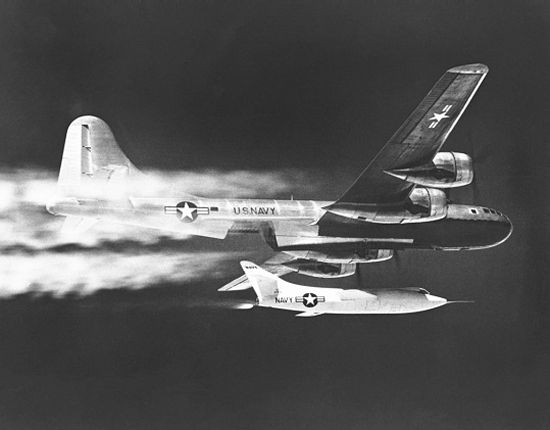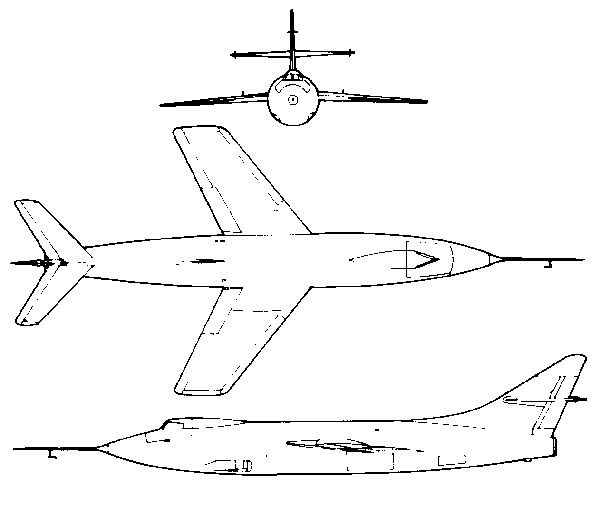|
||||||||||
|
|
||||||||||
|
||||||||||
|
|
||||||||||
 - -
|
|

|
Douglas D-558-2 Skyrocket High-Speed Research Aircraft |
|
DESCRIPTION:
When the US Navy Bureau of Aeronautics and NACA agreed to develop the D-558-1 Skystreak transonic research plane, they envisioned later replacing the design's single large turbojet with a smaller turbojet and a rocket motor to explore flight at supersonic speeds. However, review of German aerodynamic data captured at the end of World War II convinced planners and designers that the basic design should also be used to investigate the use of swept-wings. The German research and NACA wind-tunnel tests had confirmed that swept-wings offer many advantages in high-speed flight, especially raising the critical Mach number to reduce the effect of wave drag. Based on these findings, Douglas designed a completely new aircraft, the D-558-2 Skyrocket, with a larger diameter fuselage containing a turbojet for takeoff and low-speed flight as well as a rocket engine for high-speed flight. The new design also featured a mid-set wing with 35° of sweep and a swept horizontal tail assembly. Three examples of the D-558-2 were built, the first flying in 1948. This first example was powered by a turbojet only, because of slow development of the XLR-8 rocket motor, and was only capable of conventional takeoffs and landings. The second example, D-558-2 #2, was the first and only to feature the mixed powerplant and was also intended for conventional takeoffs, but was later modified to be carried aloft by a B-29 mothership and launched in flight. The #2 ship later had its turbojet deleted in favor of rocket-only propulsion, and the extra space was used for additional fuel. In this configuration, the aircraft was able to achieve Mach 2.005 at 62,000 ft (18,915 m) on 20 November 1953, thereby becoming the first aircraft to exceed Mach 2. Probably the most successful of the series, the #2 ship also set an unofficial altitide record of 83,235 ft (25,395 m) on 21 August 1953. Although overshadowed by the X-1, the Skyrocket was an exceptionally successful program that provided a great deal of useful data on supersonic flight. In particular, the D-558-2 uncovered the tendency of swept-wings to pitch-up in certain conditions and was used to explore the effects of a number of aerodynamic devices at supersonic speeds. Over 200 flights were made before the Skyrocket was retired in December 1956.
Last modified 27 September 2009
|
|
| HISTORY: | |
| First Flight |
4 February 1948
|
| CREW: |
one: pilot
|
|
ESTIMATED COST:
|
unknown
|
| AIRFOIL SECTIONS: | |
| Wing Root | NACA 63-010 |
|
Wing Tip
|
NACA 63-012
|
| DIMENSIONS: | |
| Length | 45.25 ft (13.79 m) |
| Wingspan | 25.00 ft (7.62 m) |
| Height | 11.50 ft (3.51 m) |
| Wing Area | 175.0 ft² (16.26 m²) |
|
Canard Area
|
not applicable
|
| WEIGHTS: | |
| Empty | unknown |
| Normal Takeoff | unknown |
| Max Takeoff |
(turbojet only) 10,570 lb (4,795 kg) (mixed) 15,265 lb (6,925 kg) (rocket only) 15,785 lb (7,170 kg) |
| Fuel Capacity |
internal: unknown external: unknown |
|
Max Payload
|
unknown
|
| PROPULSION: | |
| Powerplant |
one Westinghouse J34-22 turbojet and one Reaction Motors XLR-8-5 rocket motor |
| Thrust |
(J34-22) 3,000 lb (13.35 kN) (XLR-8) 6,000 lb (26.69 kN) |
| PERFORMANCE: | |
| Max Level Speed |
at altitude: 585 mph (940 km/h) at 20,000 ft (6,095 m) [turbojet only] at altitude: 720 mph (1,160 km/h) at 40,000 ft (12,190 m) [mixed, conventional takeoff] at altitude: 1,250 mph (2,010 km/h) at 67,500 ft (20,575 m) [rocket only, air-launched] at sea level: unknown |
| Initial Climb Rate | unknown |
| Service Ceiling | unknown |
| Range | unknown |
| g-Limits |
unknown
|
| KNOWN VARIANTS: | |
| D-558-2 #1 | First example built and flown, initially powered by only a turbojet until rocket motors became available, used mainly by the US Navy |
| D-558-2 #2 | Second example, used by NACA primarily to study the characteristics of swept-wings, only aircraft of the series to have mixed turbojet and rocket propulsion but was later modified to a rocket only configuration and air-launched from a B-29 mothership, set several speed and altitude records, now on display at the National Air & Space Museum |
| D-558-2 #3 | Final aircraft built and powered by rocket motor only, also modified for air-launch only, used by NACA to explore the effectiveness of wing slats and leading edge devices as well as aerodynamic effects on under-wing stores at high-speeds |
| D-558-3 |
Proposed hypersonic research aircraft derived from the D-558-2, intended to reach Mach 9 at 750,000 ft
(228,600 m) but was abandoned in favor of the X-15
|
|
KNOWN OPERATORS:
|
United States (US Navy) United States (NACA) |
|
3-VIEW SCHEMATIC:

|
|
SOURCES:
|
|


|
Aircraft | Design | Ask Us | Shop | Search |

|
|
| About Us | Contact Us | Copyright © 1997-2023 | |||
|
|
|||